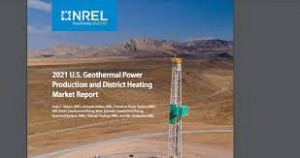From the Report of the National Renewable Energy Laboratory
Executive Summary~ This report, the 2021 U.S. Geothermal Power Production and District Heating Market Report, was developed by the National Renewable Energy Laboratory (NREL) and Geothermal Rising (previously the Geothermal Resources Council, or GRC), with funding support from the Geothermal Technologies Office (GTO) of the U.S. Department of Energy (DOE).
The report presents analysis of the current state of the U.S. geothermal market and industry for both the power production and district heating sectors, with consideration of developing power projects.
Geothermal heat pumps, although a key technology in the wider use of geothermal resources, are outside the scope of this report.
U.S. Geothermal Power Generation — Key Findings
>> Current U.S. geothermal power generation nameplate capacity is 3,673 MW from 93 power plants. Of this capacity, 1,300 MW are located on public lands.
>> California and Nevada contribute more than 90% of the current U.S. geothermal power generation, with additional contributions from plants in Alaska, Hawaii, Idaho, New Mexico, Oregon, and Utah.
>> From the end of 2015 through the end of 2019, the United States brought seven new geothermal power plants online in Nevada, California, and New Mexico, adding 186 MW of nameplate capacity. In the same time period, 11 plants were retired or classified as non- operational, subtracting 103 MW of nameplate capacity. The remaining difference in capacity from 2015 to 2019 can be attributed to the reduction of nameplate capacity at individual plants.
>> After the data for this report were collected, Ormat brought the Steamboat Hills expansion in Nevada online, increasing its generating capacity by 19 MW. In addition, in late 2020, the Puna geothermal plant was brought back online, which should increase geothermal net-generation numbers in 2021.
>> Geothermal companies operating in the United States have a combined 58 active developing projects and prospects across nine states, with a majority located in Nevada.
>> Of these projects, five are in Phase IV, the phase immediately preceding project completion. Three are located in Nevada, and two are in California.
>> From November 2019 through September 2020, nine new geothermal Power Purchase Agreements (PPAs) have been signed across four states. Included in these agreements are plans for the first two geothermal power plants to be built in California in a decade—Hell’s Kitchen and Casa Diablo IV.
>> Geothermal power provides several non-cost advantages, including supplying continuous baseload power, ancillary grid services, resilience, environmental benefits, and a small land footprint compared to other renewable energy technologies.
>> Twenty-eight states have renewable portfolio standards (RPS) that count geothermal power as an eligible resource, seven of which include direct use. RPSs support geothermal development by requiring a certain amount of electricity sold by utilities to come from renewable energy sources.
U.S. Geothermal District Heating — Key Findings
• Currently, there are 23 geothermal district heating (GDH) systems in the United States, with a capacity totaling more than 75 MW of thermal energy (MWth). The systems range in size from 0.1 MWth to over 20 MWth.
• Of these 23 commercial projects, 10 received DOE loan and grant support. Federal, state, and local funding support have proven critical to develop a majority of the existing GDH projects in the United States.
• The oldest GDH installation dates from 1892 in Boise, Idaho, and the most recent installation was completed in 2017 in Alturas, California. The remaining systems are located in California, Colorado, Idaho, New Mexico, Nevada, Oregon, and South Dakota.
• The majority of the GDH systems in the United States are more than 30 years old.
• The average U.S. levelized cost of heat (LCOH) value for GDH systems is $54/MWh, slightly lower than the average European LCOH value of $69/MWh. However, this LCOH is slightly higher than the 2019 average U.S. residential natural gas LCOH. Estimated LCOH for existing U.S. systems ranges from $15 to $105/MWh, a range that is consistent with the range of LCOH for existing European GDH systems.
• U.S. GDH systems tend to be smaller in size (average of 4 MWth) than European GDH systems (continent-wide average of ~17 MWth), and orders of magnitude smaller than the average GDH system in China (~1,000 MWth).
• U.S. GDH systems run at 23% capacity, on average. This low utilization factor is due to frequent operation at less than full capacity and the seasonality of heating needs (i.e., the system is not needed for satisfying heating demands year-round).
• As of 2020, few policy mechanisms intended to support GDH development are in place in the United States.
Conclusions ~ This report is intended to provide policymakers, regulators, developers, researchers, engineers, financiers, and other stakeholders with up-to-date information and data reflecting the 2019 geothermal power production and district heating markets, technologies, and trends in the United States. Geothermal Rising collected U.S. geothermal power production data via a questionnaire sent to all known U.S. geothermal operators and developers. This questionnaire requested information about both existing power production capacity and developing projects, which was then added to an existing GEA database and shared with NREL. For GDH systems, an NREL geothermal direct-use database
was updated with information obtained from news articles, publications, and interviews conducted in 2020 with project owners, operators, and other stakeholders.
#######+++++++#######+++++++########
Geothermal Energy Development in West Virginia ~ Here is a link to the House Bill 4098 that passed in WV on March 12, 2022, the last day of the Legislative Session for this year. It remains for the approval of the Governor, which is expected.
https://www.wvlegislature.gov/Bill_Text_HTML/2022_SESSIONS/RS/bills/HB4098%20SUB.pdf

